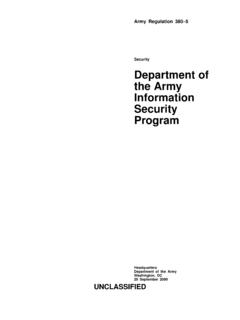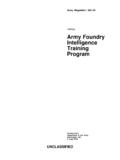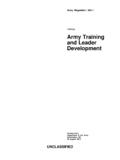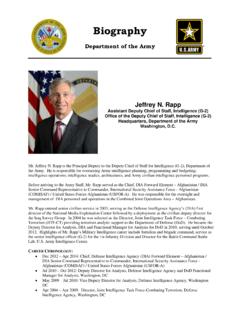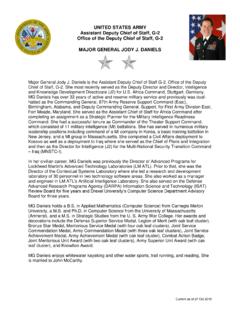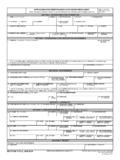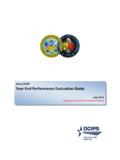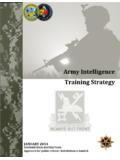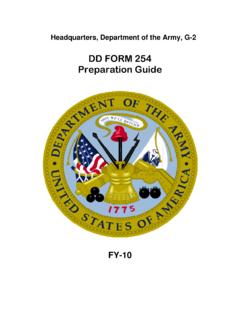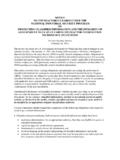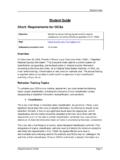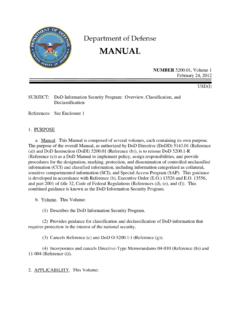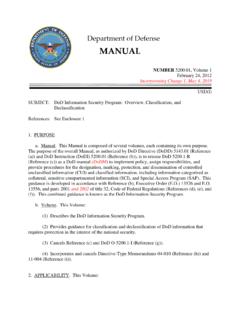Transcription of DoD Guide to Marking Classified Documents, DoD 5200.1-PH
1 DoD Guide to Marking Classified DocumentsT LApril 1997 Assistant Secretary of DefenseforCommand, Control, Communications and IntelligenceApril 28, 1997 FOREWORDThis Pamphlet is reissued under the authority of DoD Directive , information SecurityProgram, December 13, 1996. It prescribes guidance through examples, on the markings forclassified national security information . It supersedes the 1982, guidance contained is derived from the 12598, Classified National SecurityInformation, its implementing instructions, and the Marking Guide developed by the InformationSecurity Oversight Office. This pamphlet applies to the Office of the Secretary of Defense(OSD), the Military Departments, the Chairman of the joint Chiefs of Staff, the Defense Agencies,and the DoD Field Activities (hereafter referred to collectively as the DoD Components ).
2 Marking Classified information serves several purposes in the Department of Defense. It alertsholders to the presence of Classified information , identifying the exact information or portion thatneeds protection; provides guidance for downgrading and declassification; gives the reason for theinitial classification decision; and warns the holders of any special access, controls, orsafeguarding requirements. While we can not anticipate every Marking situation, this pamphletprovides the basic ground rules that apply to all Classified information , regardless of the mediaused. For specific situational needs, contact your agency s security officer for Pamphlet is effective immediately for use by all the DoD Components. The Heads of theDoD Components may issue supplementary instructions when necessary to provide for uniquerequirements within their recommended changes to the Pamphlet to:Office of the Assistant Secretary of Defense for Command, Control, Communications, and IntelligenceDirector, Security Programs6000 Defense PentagonWashington, DC 20301-6000 The DoD Components may obtain copies of this Pamphlet through their own Publicationschannels.
3 Approved for public release; distribution unlimited. Authorized registered users mayobtain copies of this Publication from the Defense Technical information Paige, of ContentsForewordTable of ContentsSecurity RemindersSection 1 - Marking Originally Classified Documents Portion Markings and Overall Classification Markings Classified by and Reason for Classification Line Declassify on Line Exemption Categories chartWorking PapersElectronically Transmitted MessagesSection 2 - Marking Derivatively Classified DocumentsClassifying from Multiple Sources Marking from a Classification Guide Section 3 - Marking Special Types of information and ExtensionsForeign Government information Letters of TransmittalAtomic Energy InformationClassification by Compilation Special Access ProgramsSection 4 - OtherAutomatic Declassification Instructions - 25 yr.
4 RuleMarking information Other Than DocumentsReferencesSecurity RemindersA. Classification decisions are either original or Only individuals occupying positions specifically authorized in writing may classify Only individuals with the appropriate security clearance, who are required by their work togenerate Classified source information , may classify There are three levels of classification, TOP SECRET , SECRET and CONFIDENTIAL. Do not use other terms, such as Official Use Only, or Administratively Confidential, to identify Classified national security information shall not be Classified for any reason unrelated to the protection of Classifiers are responsible for assuring that information is appropriately Classified and properlymarked. The proper markings include declassification To have access to Classified information , a person must have a security clearance at anappropriate level, a signed SF 312, Classified information Nondisclosure Agreement, andthe need-to-know.
5 H. Individuals who believe that information in their possession is inappropriately Classified , orinappropriately unclassified, are expected to bring their concerns to the attention of theirsecurity manager or the classifier of the information for Classified information shall not be discussed or read in public places. It should not be leftunattended, even for a short time in automobiles, hotel rooms, private residences or publiclockers. Only approved security containers are authorized for Classified information shall not be discussed on non-secure telephones. Talking around is adangerous practice and does not provide adequate protection to Classified national Notes, rough drafts, informal working papers, and other preliminary documents must behandled and destroyed as Classified information .
6 This is especially important with computergenerated documents that often go through several revisions. Apply the markings as thedocument is being 1 - Marking Originally Classified DocumentsSECRETSECRETOFFICE OF THE SECRETARY OF DEFENSEWASHINGTON, DCMEMORANDUM FOR DASD (I&S)SUBJECT: Classification Markings (U)1.(U)This is an example of a document that contains originally Classified information . Standardmarkings are required for all documents as shown here. These markings include:a. (U) Portion Marking (s) for each section of a document to reflect the classification of theinformation. When using subsections such as shown here, individual markings are used. Whensubsections are not marked, the information is protected at the level of protection shown by theoverall (U) Overall markings conspicuously using larger font size or (U) A Classified by line that includes the name or personal identifier and position of (S) A reason for classification as shown on page 8 of this (U) A Declassify on line that indicates the following:(1) The date or event for declassification not to exceed 10 years.
7 (2) The date that is 10 years from the date of the original decision.(3) An extension beyond the initial 10 years of classification.(4) An authorized and applicable exemption category(ies) as described on page 10 of (S)If this paragraph contained Secret information , the portion would be marked with thedesignation S in parentheses. If the paragraph contained Confidential information , the portionwould be marked with the designation C in by:Emmett Paige, (C3I) (a) and (d)Declassify on:December 31, : A line followed by a reference number, throughout this pamphlet, cites the paragraphnumber found on the same pagePortion Markings and Overall Classification MarkingClassified by:Emmett Paige, Jr., ASD(C3I) (a) and (d)Declassify on:December 31, XXXXSECRETSECRETOFFICE OF THE SECRETARY OF DEFENSEWASHINGTON, DCMEMORANDUM FOR DASD (I&S)SUBJECT: Portion Markings and Overall Classification Marking (U)1.
8 (U)The first step in Marking a document is to identify the classification level of eachportion contained in the document . This includes each paragraph, subjects, and titles. Onlyby identifying the proper classification for each portion can the overall classification level (U) The three sample paragraphs shown here contain Unclassified, Secret, and Confidential information , respectively. Portion markings consist of theletters (U) for unclassified, (C) for Confidential, (S) for Secret, and (TS) for Top Secret. b. (U) These abbreviations are placed, in parentheses, before the portion, or afterthe title to which they (U) Whenever possible, use an unclassified title or subject line. If a classifiedtitle and/or subject is necessary, follow it with a short, unclassified (S) The second step in classifying a document is determining the overall classificationof the document .
9 The overall classification is determined by the highest classification levelof information contained in the document . In the example shown here, Secret is thehighest level of classification. This is paragraph 2. If it were to contain Secret information , this portion would be marked with the designation S in (C) Conspicuously place the overall classification at the top and the bottom of thepage. This is paragraph 3. If it were to contain Confidential information , this portionwould be marked with the designation C in Markings and Overall Classification MarkingSECRETSECRET4.(U) Mark each internal page with theoverall classification, or with the highestclassification level of information contained onthat (S) This is paragraph 5. If it were to contain Secret information , this portion would bemarked with the designation S in (U) When using overall Marking on everypage of a document , ensure that extracts of thedocument are remarked to reflect actualclassification and source (U) This is paragraph 5.
10 If it were tocontain Unclassified information , this portionwould be marked with the designation U (U) This is paragraph 4. It is anunclassified paragraph and is therefore markedwith a U as other portions on this page areclassified. Should this paragraph be used tocreate another document , the information takenfrom this paragraph from this page would (S)This is paragraph 5. Should thisparagraph contain Secret information , thisportion would be marked with the designation S as indicated at the beginning of thisparagraph. The overall classification on thispage is marked Secret because this paragraphcontain Secret information , which is the highestSECRET(S)level of classification contained on thepage. When a Classified or unclassifiedparagraph is too long and must be carried overto another page, the classification MUST becarried forward as (U) This is paragraph 6.
